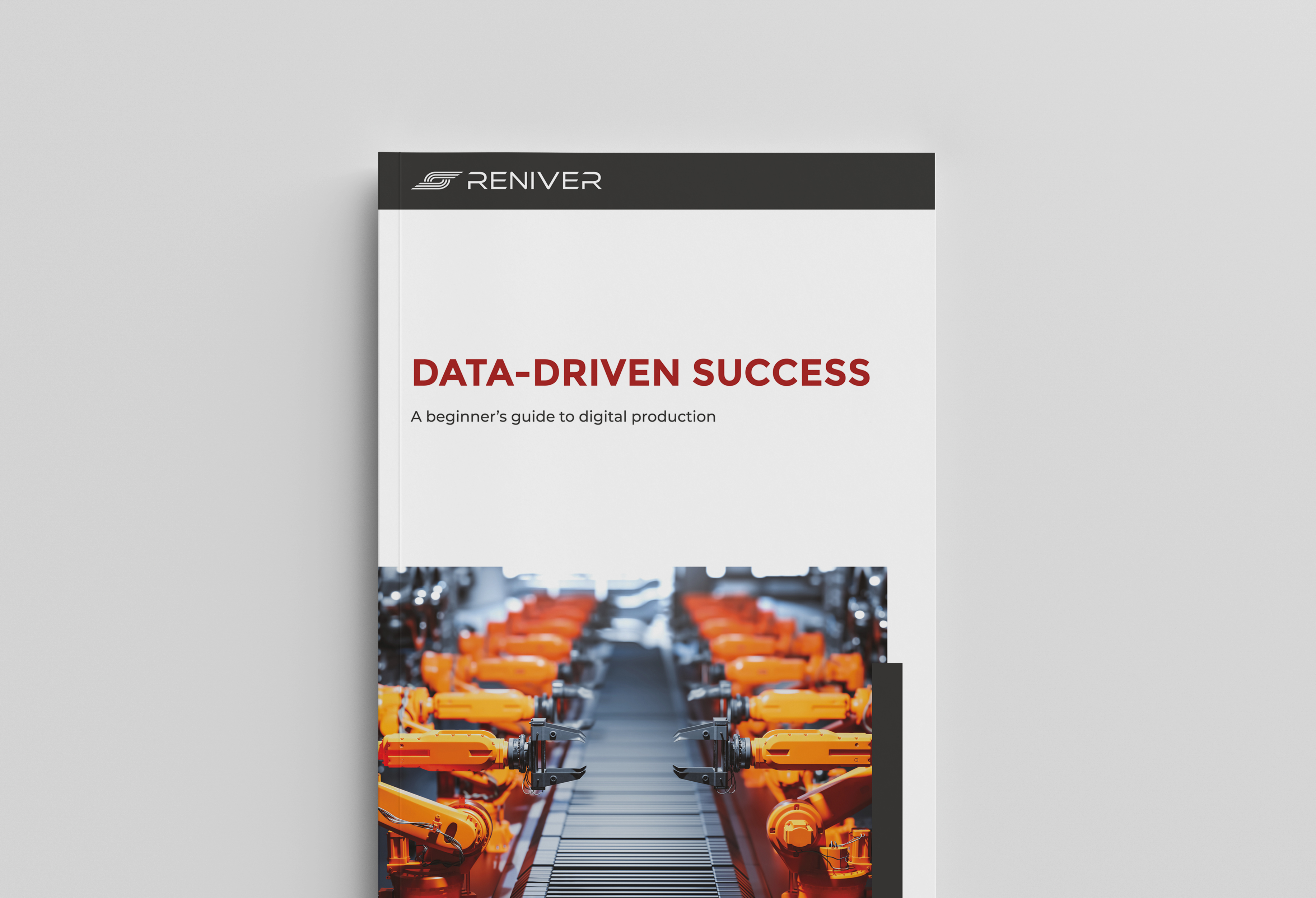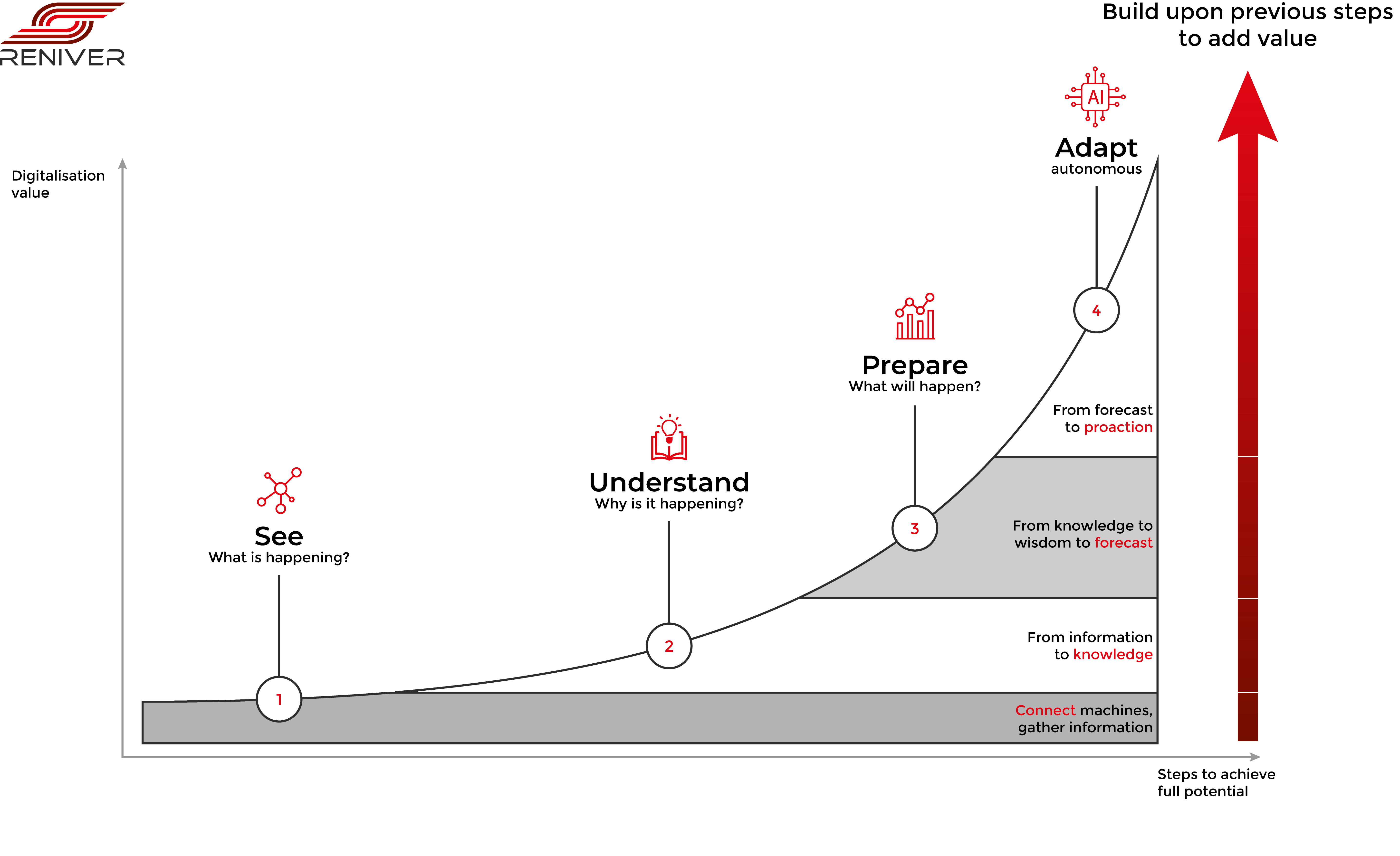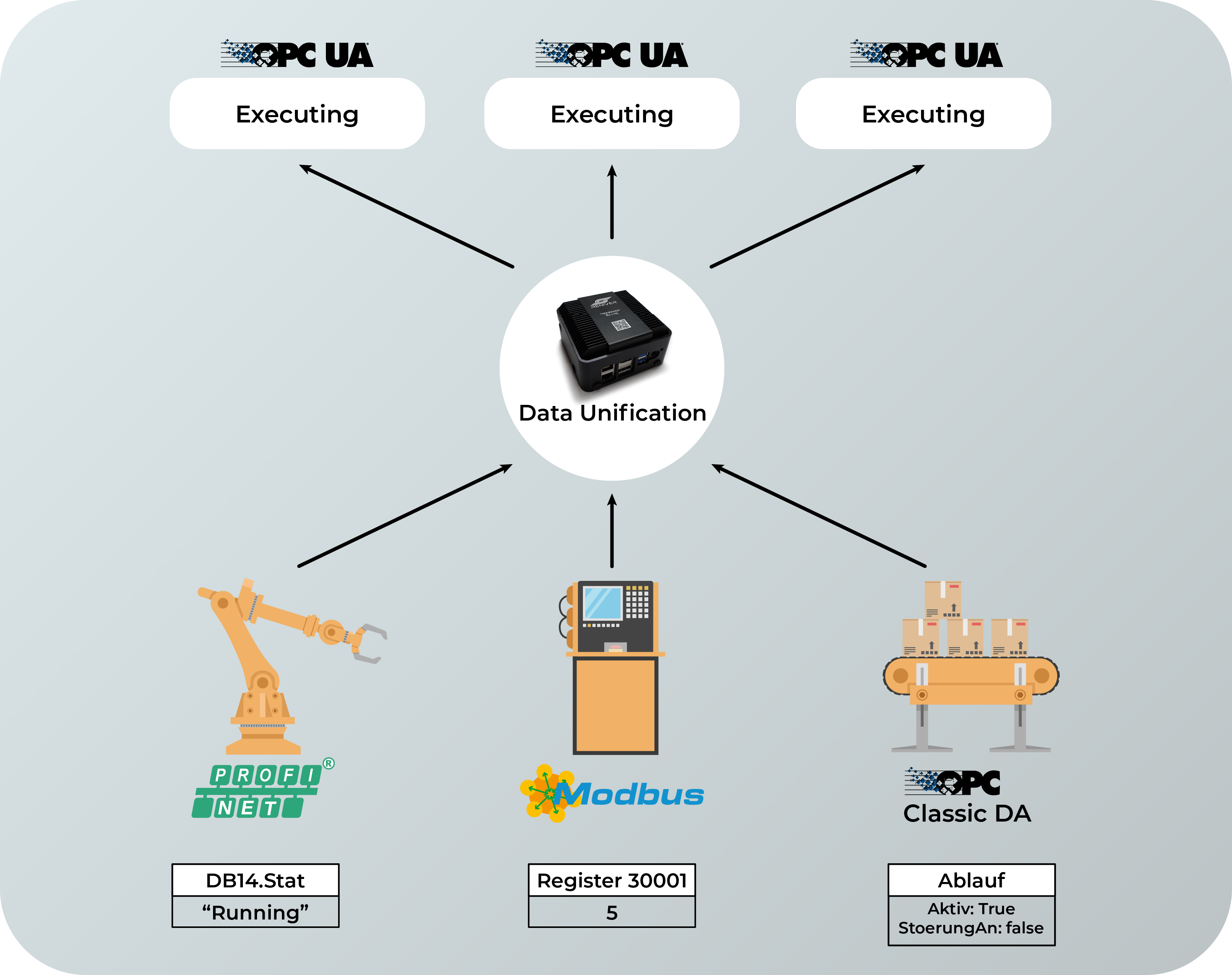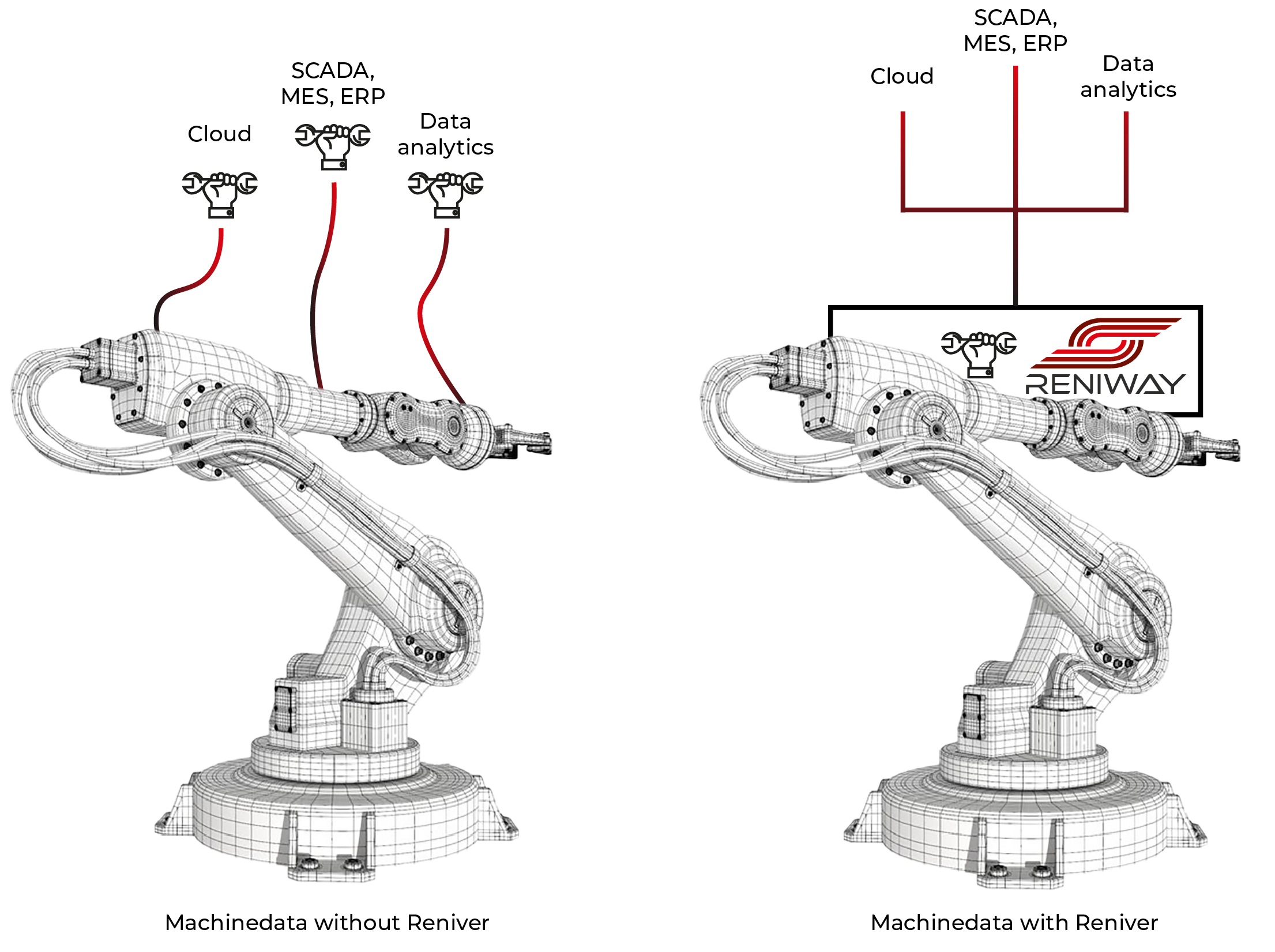Data-Driven Success – a Beginner’s Guide to Digital Production
This article contains tips and our best practices for you to start connecting your industrial devices and machines the right way.

Table of Contents:
- Introduction
- The potential value of production data
- The difficulties of connecting your machines
- How to start with your industrial digitalization
- The importance of strong leadership
- The value of data modeling
- Things to consider
- Conclusion
1. Introduction
In today's fast-paced and competitive business landscape, companies need to stay ahead of the curve in order to succeed. With the rise of Industry 4.0, businesses are increasingly turning to machine connectivity and data-driven applications to optimize their operations and gain a competitive edge. By connecting machines and capturing data, businesses can gain valuable insights into their operations, enabling them to make data-driven decisions, reduce downtime, and boost productivity. From predictive maintenance to real-time monitoring, the benefits of machine connectivity and data capturing are clear, and businesses that fail to embrace this technology risk falling behind.
In this article you will learn:
- The value production data can generate
- Guidance on taking the first steps towards machine connectivity
- The significance of strong leadership
- What is data modelling and why is it important?
- Some helpful tips before you start with your road towards a digital production
2. The Potential Value of Production Data
Machine data has the potential to create insights of high value that can give companies a big competitive edge. But every successful story has a beginning.

See: What is happening
Capturing data is the starting point for understanding what is happening in your business operations, and without it, it is impossible to gain insights and make informed decisions. In many ways, machine data can be thought of as the foundation of a house. Just as a strong foundation is essential for a house to stand the test of time, machine data is the essential building block for businesses to thrive in the long term. It is the step where you begin to see what is going on in your operations, and without a clear understanding of this foundation, it can be difficult to build anything of lasting value on top of it. An example that illustrates the significance of machine data is machine downtime. By leveraging machine data insights, you can easily detect and monitor downtime occurrences, even remotely.
Understand: Why is it happening
Once machine data is captured correctly, the next step is to start understanding what is happening and more importantly, why it is happening. This process not only empowers businesses with valuable insights but also cultivates knowledge and experience among the employees. By presenting information in a clear and accessible manner, machine data allows the workforce to build a deeper understanding of the operations, identify patterns, and make informed decisions. In our example, by analysing the machine data, you will not only know why the machine stopped working but also be able to take immediate action to reinstate the production line, minimizing downtime and ensuring continuous operations.
Prepare: What will happen?
Once businesses have a clear understanding of what is happening in their operations, they can prepare for what will happen in the future. Here forecasting comes into play, which involves using predictive analytics and other techniques like anomaly detection to anticipate potential issues or opportunities. In our example, you will be able to use machine data to identify potential maintenance issues before they become critical. Businesses can then put the right people in motion to perform preventive maintenance and avoid costly downtime.
Adapt: Autonomous response
The final step in the evolution of digitalization is that systems automatically take proactive actions based on forecasting knowledge. They continuously adapt to current situations and future events. When a maintenance issue is detected, the planning system can automatically adapt production, making sure that high priority orders are not compromised by maintenance issues. The big difference between step 3 is that systems will adapt their production schedule automatically based on predictive maintenance issues, without the need of human interference.
Note It's important to remember that the key to success in all steps is a solid operational data foundation. Without accurate and reliable operational data, even the most advanced predictive analytics techniques will fall short.
3. The Difficulties of Connecting Your Machines

The process of connecting your machines can be a daunting task due to several reasons. Legacy machines with outdated technology, proprietary or closed interfaces, undocumented data tags, and the looming presence of cybersecurity risks all contribute to the complexity and difficulty of establishing seamless connections. In this chapter, we shed light on the hurdles that organizations face when embarking on their journey towards machine connectivity.
Legacy machines
One of the main challenges of connecting machines is dealing with legacy equipment. Many businesses still rely on older machines that were not designed with connectivity in mind. As a result, these machines may not have the necessary sensors, communication protocols, or data interfaces to easily capture and transmit machine data. Retrofitting legacy machines with new sensors or communication hardware can be a complex and expensive process and may require significant downtime or production interruptions.
Proprietary or closed interfaces
Some machine manufacturers or software vendors may use proprietary communication protocols or data formats that are not compatible with other systems. This can make it difficult to extract machine data and integrate it with other applications or platforms. In some cases, businesses may need to use specialized adapters or custom software to bridge the gap between different systems, which can be time-consuming and costly. Additionally, some vendors may limit access to machine data or charge additional fees for data integration, which can further complicate the process of connecting machines.
Undocumented data tags
Machine data may be captured using different types of sensors, controllers, or data loggers, each of which may use its own data format or naming convention. Without a standardized approach to data tagging and documentation, it can be difficult to identify and understand the meaning of different data elements. This can make it challenging to integrate machine data with other systems or to perform analytics on the data. In some cases, businesses may need to invest in data mapping or data normalization tools to reconcile different data formats, which can be time-consuming and expensive.
Cyber-security risks
As machines become more connected and integrated with IT systems, they may become vulnerable to cyberattacks or data breaches. These risks can include unauthorized access to sensitive data or control systems, as well as the potential for malware or ransomware attacks. In some cases, cyberattacks on OT systems can also cause physical damage or safety risks, which can have serious consequences for businesses and employees.
Note Most machines are not designed to be connected and smart.
4. How To Start With Your Industrial Digitalization

In this chapter, we will advise you on five crucial steps to kickstart the digitalization of your production processes. By addressing key aspects such as goal setting, stakeholder engagement, data identification, cost-effective sensor integration, establishment of reliable data pipelines, and implementation of effective notification systems, we provide you with the necessary guidance to embark on your digital transformation journey with confidence and ease.
Step 1: Think about your goal
Defining your goal with machine data is crucial before starting the process of connecting your machines. Ask yourself what you want to achieve with this data and how it can benefit your business. Do you want to increase machine uptime, reduce maintenance costs, or optimize production processes? It's important to start simple and focus on the most important data points first, rather than trying to capture all available data at once. This approach can help you avoid overwhelming complexity and enable you to see quick wins and ROI from your efforts.
Step 2: Talk to the people doing the job
Before diving into machine data, it's important to talk to the people working with the machines on a daily basis. These people have unique insights into the challenges and opportunities that can be addressed through data analysis. By understanding their perspectives, you can identify the data that will be most valuable to their work and also gain buy-in and support for your project.
Step 3: Identify needed data, adding sensors is cheap
Identifying the needed data is crucial in achieving your machine data-related goals. Adding sensors is relatively inexpensive and provides additional data that can help identify areas for improvement. It's important to keep in mind that not all data is relevant and that collecting too much data can lead to analysis paralysis.
Step 4: Built data pipelines for live insights
Once you have successfully connected your machines and started collecting valuable data, it's time to establish robust data pipelines to ensure smooth and continuous flow of information. Data pipelines are essential for processing, organizing, and analysing the data in real-time, enabling you to derive immediate insights and take proactive actions. Implementing a reliable data pipeline architecture, which includes data ingestion, storage, processing, and visualization components, will empower you to monitor machine performance, identify anomalies, and make data-driven decisions in a timely manner.
Step 5: Notify the right people to act and improve
Having access to valuable machine data and real-time insights is only impactful if the right people within your organization can act upon it promptly. Establishing effective notification systems is key to ensuring that the relevant individuals are alerted when specific conditions or events occur. By setting up automated alerts or notifications, you can proactively notify maintenance teams, operators, or supervisors about critical issues, anomalies, or opportunities for improvement. This allows for swift action and enables timely interventions to minimize downtime, address potential failures, quality issues, or optimize production processes. Consider integrating the notification systems with existing communication channels like MS Teams or dedicated applications to ensure seamless information dissemination and prompt response.
Note Investing in digital transformation goes beyond the implementation of new technologies - it requires strong leadership to drive the transformation and ensure its success.
5. The Importance of Strong Leadership

Cultivate a supportive environment
Before embarking on investments in Industry 4.0, it's crucial to create a strong support base within your organization. This involves garnering buy-in and support from both executives and the people directly involved in the day-to-day operations. Engage in open and transparent communication to help employees understand the potential benefits and opportunities that digital production technologies can bring. By fostering a culture of support and collaboration, you can encourage active participation, idea sharing, and innovation throughout the organization.
Establish a strategic vision:
Strong leadership entails having a clear strategic vision for the integration of digital production technologies. Develop a roadmap that outlines the desired outcomes, milestones, and steps needed to achieve your goals. This vision should align with your overall business objectives and consider the specific needs and challenges of your industry. By articulating a compelling vision, leaders can rally the support and commitment of stakeholders, inspiring them to embrace the changes and actively contribute to the transformation journey.
Eliminate fear and uncertainties:
The adoption of digital production technologies may be met with fear and uncertainties among employees. Strong leadership plays a crucial role in addressing these concerns and providing reassurance. Encourage open dialogue, actively listen to employee perspectives, and address their questions and apprehensions. Promote a learning culture that fosters continuous education and upskilling opportunities, helping employees adapt to the changing technological landscape. By creating an environment that encourages growth and learning, leaders can alleviate fears and build confidence in the benefits of digitalization.
Focus on smart road mapping:
It's important to emphasize that the impact of digital production technologies is not solely determined by the size of your budget. Strong leadership understands the value of strategic planning and creating a smart roadmap. Prioritize investments based on their potential to deliver meaningful outcomes and return on investment. Identify low-hanging fruit and quick wins that can generate enthusiasm and demonstrate the value of the initiatives. By strategically allocating resources and optimizing the use of available funds, you can maximize the impact of your investments, even with limited budgets.
In conclusion
Strong leadership is paramount when embarking on investments in digital production technologies. By cultivating a supportive environment, establishing a strategic vision, addressing fears and uncertainties, and focusing on smart road mapping, leaders can guide their organizations towards successful digital transformations. With effective leadership, organizations can navigate the challenges, inspire their workforce, and unlock the full potential of Industry 4.0 technologies for sustainable growth and competitiveness.
6. The Value of Data Modeling

What is it?
Data modeling is the process of organizing and structuring data in a way that allows industrial machines to exchange information with each other and with other systems in a standardized and reliable manner. It involves defining the types of data that can be exchanged, as well as establishing the relationships and structure between different data elements. OPC UA (Unified Architecture) is one example of a communication protocol that incorporates data modeling to enable seamless data exchange among industrial machines and systems. Data models typically capture details like operational characteristics (state, mode, power consumption, output capabilities) as well as process control parameters (recipe control, settings, sensors, actuators). A well-designed data model ensures that machine data can be effectively analyzed and used to drive actionable insights and business decisions.
Giving data meaning at the source: Why?
Applying data modeling at the source (on the machine itself or edge device) can save a significant amount of work when connecting to different target systems like ERP (Enterprise Resource Planning), SCADA (Supervisory Control and Data Acquisition), analytics, and cloud platforms. One practical example is in the context of predictive maintenance. By utilizing data modeling at the machine level, consistent and standardized datasets can be collected and shared across various systems. For instance, data related to machine health, performance parameters, sensor readings, and maintenance logs can be structured and organized using data models and seamlessly shared. This saves time and effort, as there is no need for extensive data transformation or mapping between different formats and structures. Furthermore, having consistent datasets enables the utilization of artificial intelligence (AI) techniques more effectively. For example, machine learning algorithms can be trained using standardized data from various machines, allowing AI models to learn patterns and make accurate predictions for predictive maintenance or anomaly detection.

7. Things To Consider
Invest in data collection to prepare for cloud
More and more production companies are using hybrid on-premises/cloud architecture. Cloud-based systems like Microsoft Azure, Amazon AWS or Siemens Mindsphere offer pre-configured solutions and architectures tailored specifically to the needs of production companies. These solutions fast-track implementation of use-cases like condition monitoring, predictive maintenance, supply chain optimization, and demand forecasting. With a pre-configured cloud solution, production companies can quickly connect their equipment and assets to the cloud using data hubs like Azure IoT Hub or AWS IoT Core. The company can then leverage the power of digital twin services like Azure Digital Twins or AWS IoT Digital TwinMaker to create virtual representations of their assets and link them to real-time data sources. Furthermore, using streaming analytics, such as Azure Stream Analytics or AWS Kinesis Analytics, enables monitoring equipment health in real-time, detect anomalies, and trigger proactive maintenance actions. While cloud-based solutions offer valuable tools and architectures for production companies, it is crucial to emphasize that the effectiveness of these solutions relies heavily on a solid on-premises data collection infrastructure. To fully leverage the benefits of cloud-based systems, production companies need to ensure that their machines and production equipment have reliable and accurate data collection mechanisms in place.
Use open standards like OPC UA and MQTT
Use open standards like OPC UA and MQTT when connecting machines to avoid vendor lock-in, ensuring that machines and software from different vendors can seamlessly exchange data and allowing your company the freedom to choose hardware and software solutions based on the best fit for your specific needs, future scalability, and the ability to leverage a wider range of innovations and solutions from the market.
Change policy to buy smart machines
When purchasing or building a new machine, it is important to not only consider the mechanical aspects, but also the digital ones. By specifying the data and communication capabilities of the machine upfront, costs will be reduced. You will also ensure that it can easily connect to your existing infrastructure and provide the data you need. This includes selecting machines with open communication protocols, as well as ones that are designed to integrate with other systems.
8. Conclusion
In conclusion, the journey towards unlocking the true value of data in Industry 4.0 requires a multi-faceted approach. While the potential for data-driven insights and predictive analytics is immense, it all begins with a solid machine data foundation. Without accurate and reliable data captured at the source, even the most advanced analytics techniques will fall short of delivering meaningful results. Connecting machines poses their own set of challenges, as most machines were not initially designed to be connected or smart. However, with the right strategies and considerations, it is possible to bridge this gap and enable seamless data exchange between machines and systems. To embark on this transformative path, strong leadership is paramount. Leaders must cultivate a supportive environment, define a strategic vision, and address concerns to rally the organization behind the digitalization efforts. Data modelling and giving data meaning at its source emerge as critical aspects. By implementing effective data modelling techniques, organizations can ensure consistency, standardization, and contextualization, empowering them to extract actionable insights from the data. Additionally, when evaluating technology options, such as cloud solutions, it is crucial to assess the fit for your specific needs. Embracing open standards and including digital aspects in your buying policy can foster interoperability and future scalability. By embracing these elements and leveraging the transformative power of data, organizations can navigate the complexities of the digital age and thrive in a rapidly evolving business landscape.